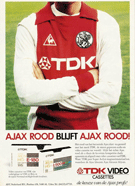Even assuming that there is a difference in legal meaning
 HvJ EG, 12 december 2008, beschikking in zaak C-197/07 P, Aktieselskabet af 21. november 2001 tegen OHIM / TDK Kabushiki Kaisha (TDK Corp.) (Nederlandse vertaling nog niet beschikbaar).
HvJ EG, 12 december 2008, beschikking in zaak C-197/07 P, Aktieselskabet af 21. november 2001 tegen OHIM / TDK Kabushiki Kaisha (TDK Corp.) (Nederlandse vertaling nog niet beschikbaar).
Merkenrecht. Beschikking. Aanvraag voor gemeenschapswoordmerk TDK. Oppositie op grond van oudere gemeenschaps- en nationale woord- en beeldmerken TDK. Ongerechtvaardigd voordeel trekken. “It must be noted that it is not necessary to demonstrate actual and present injury to an earlier mark.” Over het verschil tussen ‘reputation’ en ‘repute’. En of dat relevant is.
Ter herinnering, dit was de zaak waarin het GvEA oordeelde dat sponsoring bijdraagt aan de bekendheid van een merk.
“19. The appellant essentially maintains that the Court of First Instance wrongly based its conclusion with regard to the existence of an unfair advantage on the notion of ‘reputation’, in English, of the earlier marks, whereas Article 8(5) of Regulation No 40/94 requires that the existence of such an advantage be based on the notion of ‘repute’, in English. It claims in that regard that that provision of the regulation differentiates between those two notions. The former simply means that the trade mark is known by a significant part of the relevant public, whereas the latter requires the existence of a particular image of the mark.
21. In this case, even assuming that there is a difference in legal meaning between ‘reputation’ and ‘repute’, in English, referred to in Article 8(5) of Regulation No 40/94, it need merely be stated that, as is clear from paragraphs 62 to 67 of the judgment under appeal, the Court of First Instance correctly established the existence of an unfair advantage within the meaning of that provision by relying, in any event, on a certain image of the earlier marks in question, resulting from the intervener’s event sponsorship activities, in particular sponsorship of sport events.
22. With regard to the appellant’s argument concerning the standard of proof required of the existence of unfair advantage taken of the repute of the earlier mark, it must be noted that it is not necessary to demonstrate actual and present injury to an earlier mark; it is sufficient that evidence be produced enabling it to be concluded prima facie that there is a risk, which is not hypothetical, of unfair advantage or detriment in the future.
23. In the present case, it is clear that the Court of First Instance, in paragraph 67 of the judgment under appeal, properly established the existence of an unfair advantage within the meaning of Article 8(5) of Regulation No 40/94 in correctly considering that it had available to it evidence enabling it to conclude prima facie that there was a risk, which was not hypothetical, of unfair advantage in the future.
25. It follows from all of the foregoing that the appeal must be dismissed as in part clearly inadmissible and in part clearly unfounded.”























































































